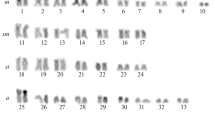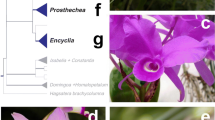Abstract
C-banded karyotypes, DNA content and the male meiiotic process ofTriatoma platensis andTriatoma delpontei are compared with those ofTriatoma infestans, the main vector of Chagas disease in South America. These three species present the same diploid chromosome number 2n=22 (20 autosomes+XX♂/XY♀). They also have several cytogenetic traits that differ from all other triatomines: large autosomes, C-heterochromatic blocks and meiotic heteropycnotic chromocenters formed by autosomes and sex chromosomes. In spite of these similarities, each species presents different chromosomal behavior during male meiosis, distinct DNA content and a specific amount and localization of the C-heterochromatin. The differences in DNA content are mainly due to the variation in C-heterochromatin amount, which may be interpreted as loss and/or gain of C-regions. This interpretation is supported by the presence of meiotic and mitotic chromocenters that facilitate the transference of C-positive material. The cytogenetic data presented in this work suggest thatT. infestans andT. platensis are more closely related to each other than toT. delpontei. It can also be inferred that the differences in distribution and amount of heterochromatin do not play a direct role in speciation in this group.
Similar content being viewed by others
References
Abalos J (1948) Sobre híbridos naturales y experimentales deTriatoma.Rev Inst Med Reg 2: 209–223.
Butlin R (1989) Reinforcement of Premating Isolation. In: Otte D, and Endler JA, eds.Speciation and Its Consequences. Sunderland, MA: Sinauer Associates, pp 158–179.
Camacho JPM, Belda J, Cabrero J (1985) Meiotic behaviour of the holocentric chromosomes ofNezara viridula (Insecta, Heteroptera) analyzed by C-banding and silver impregnation.Can J Cytol 27: 490–497.
Darnell J, Lodish H, Baltimore H (1986)Molecular Cell Biology. New York: WH Freeman.
Dey SK, Wangdi T (1990) Banding patterns of the holocentric chromosomes in some species of Heteroptera.Cytologia 55: 181–186.
Dias JCP (1986). Aspectos socio-culturales y económicos relativos al vector de la enfermedad de Chagas. In: Carcavallo R, Rabinovich J, Ton R, eds.Factores biológicos y ecológicos de la Enfermedad de Changas, Vol. II. OPS. Centro Panam Ecol Hum y Serv Nac Chagas Bs. As. Rep. Argentina, pp 289–305.
Dujardin JP, Tibayrenc M, Venegas Eet al. (1987) Isozyme-evidence of lack of speciation between wild and domesticTriatoma infestans (Heteroptera: Reduviidae) in Bolivia.J Med Entomol 24: 40–45.
Heitz E (1933) Die Herkunft der Chromocentren.Planta 18: 571–636.
Lent H, Wygodzinsky P (1979) Revision of the Triatominae (Hemiptera, Reduviidae), and their significance as vectors of Chagas' disease.Bull Am Mus Nat Hist 163: 123–520.
Mazzotti L, Osorio MT (1942) Cruzamientos experimentales entre varias especies de triatomas.Rev Med Mex 22: 215–222.
Noé J, Silva R (1949) Una nueva variedad deTriatoma infestans Klug, 1834.Bol Inform Parasit Chil 4: 565–566.
Panzera Fco, Alvarez F, Sanchez-Rufas Jet al. (1992) C-heterochromatin polymorphism in holocentric chromosomes ofTriatoma infestans (Hemiptera-Reduviidae).Genome 35: 1068–1074.
Papeschi AG (1988) C-banding and DNA content in three species ofBelostoma (Heteroptera) with large differences in chromosome size and number.Genetica 76: 43–51.
Pérez R, Panzera Y, Scafiezzo S.et al. (1992) Cytogenetics as a tool for triatomine species distinction (Hemiptera-Reduviidae).Mem Inst Oswaldo Cruz 87: 353–361.
Romaña C, Abalos J (1947)Triatoma delpontei nueva especie n. sp. (Hemiptera, Reduviidae).An Inst Med Reg (Tuc) 2: 79–93.
Schofield CJ (1988) Biosystematics of Triatominae. In: Service MW, ed.Biosystematic of Haematophagous Insects. Systematic Assoc, Spec. Vol.37, Oxford: Clarendon Press, pp 284–312.
Schofield CJ (1994) Triatominae.Biología y Control. UK: Eurocommunica Publications, pp 1–77.
Schreiber G, Pellegrino J (1950) Eteropicnosi di autosomi come possible meccanismo di speciazione (Ricerche citologiche su alcuni Emitteri neotropici).Sci Genet 3: 215–226.
Schreiber G, Carvalho HC, Espínola HN (1967) Genetics ofTriatoma and other vector species. In: Wright JW, Pal R, eds.Genetics of Insect Vectors of Disease, Amsterdam: Elsevier, pp 441–456.
Schreiber G, Bogliolo AR, Coelho de Pinho A (1972) Cytogenetics of Triatominae: Caryotype, DNA content, nuclear size and heteropyknosis of autosomes.Rev Brasil Biol 32: 255–263.
Schweizer D, Loidl J (1987) A model for heterochromatin dispersion and the evolution of C-band patterns.Chrom Today 9: 61–74.
Solari AJ (1979) Autosomal synaptonemal complexes and sex chromosomes without axes inTriatoma infestans (Reduviidae, Hemiptera).Chromosoma 72: 225–240.
Solari AJ, Agopián S (1987) Recombination nodules, synaptonemal complexes and heterochromatin in the hemipteranTriatoma infestans.Microsc Electron Biol Cel 11: 179–189.
Sumner AT (1972) A simple technique for demonstrating centromeric heterochromatin.Exp Cell Res 75: 304–306.
Ueshima N (1966) Cytotaxonomy of the Triatominae (Reduviidae: Hemiptera).Chromosoma 18: 97–122.
Usinger RL, Wygodzinsky P, Ryckman RE (1966) The biosystematics of Triatominae.Annu Rev Entomol 11: 309–330.
Vaio ES De, Grucci B, Castagnino AMet al. (1985) Meiotic differences between three triatomine species (Hemiptera, Reduviidae).Genetica 67: 185–191.
WHO (1990) Chagas disease. Frequency and geographical distribution.Weekly Epidem. Res. Relevé Epidémiologique Hebdomadaire 65: 257–264.
Wygodzinsky P, Briones S (1954) Nota sobre mutaciones del color del ojo enTriatoma infestans (Klug).An Inst Med Reg (Tuc) 4: 115–117.
Author information
Authors and Affiliations
Corresponding author
Rights and permissions
About this article
Cite this article
Panzera, F., Perez, R., Panzera, Y. et al. Karyotype evolution in holocentric chromosomes of three related species of triatomines (Hemiptera-Reduviidae). Chromosome Res 3, 143–150 (1995). https://doi.org/10.1007/BF00710707
Received:
Revised:
Accepted:
Issue Date:
DOI: https://doi.org/10.1007/BF00710707




